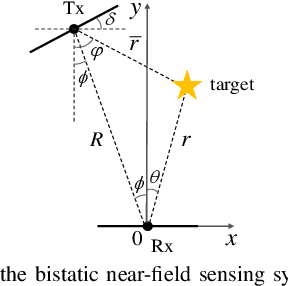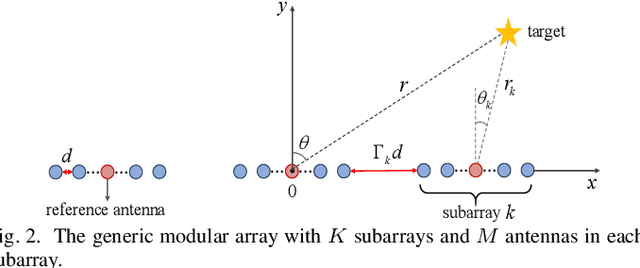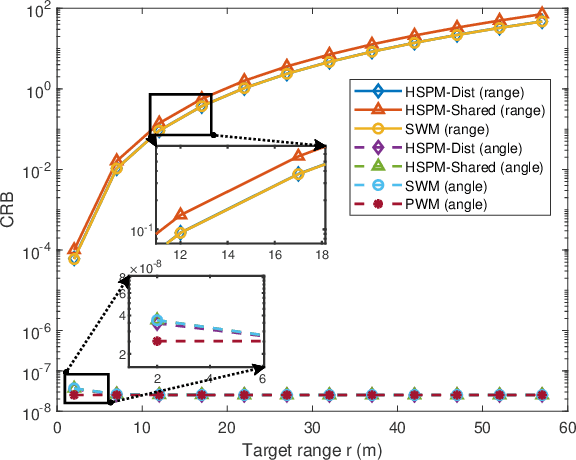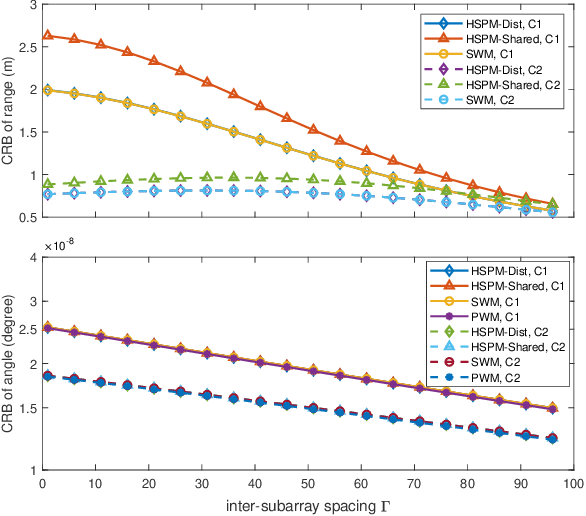Chunwei Meng
Near-Field Motion Parameter Estimation: A Variational Bayesian Approach
Feb 22, 2025Abstract:A near-field motion parameter estimation method is proposed. In contract to far-field sensing systems, the near-field sensing system leverages spherical-wave characteristics to enable full-vector location and velocity estimation. Despite promising advantages, the near-field sensing system faces a significant challenge, where location and velocity parameters are intricately coupled within the signal. To address this challenge, a novel subarray-based variational message passing (VMP) method is proposed for near-field joint location and velocity estimation. First, a factor graph representation is introduced, employing subarray-level directional and Doppler parameters as intermediate variables to decouple the complex location-velocity dependencies. Based on this, the variational Bayesian inference is employed to obtain closed-form posterior distributions of subarray-level parameters. Subsequently, the message passing technique is employed, enabling tractable computation of location and velocity marginal distributions. Two implementation strategies are proposed: 1) System-level fusion that aggregates all subarray posteriors for centralized estimation, or 2) Subarray-level fusion where locally processed estimates from subarrays are fused through Guassian product rule. Cram\'er-Rao bounds for location and velocity estimation are derived, providing theoretical performance limits. Numerical results demonstrate that the proposed VMP method outperforms existing approaches while achieving a magnitude lower complexity. Specifically, the proposed VMP method achieves centimeter-level location accuracy and sub-m/s velocity accuracy. It also demonstrates robust performance for high-mobility targets, making the proposed VMP method suitable for real-time near-field sensing and communication applications.
Hybrid Beamforming Design for Near-Field ISAC with Modular XL-MIMO
Jun 18, 2024



Abstract:A novel modular extremely large-scale multiple-input-multiple-output (XL-MIMO) integrated sensing and communication (ISAC) framework is proposed in this paper. We consider a downlink ISAC scenario and exploit the modular array architecture to enhance the communication spectral efficiency and sensing resolution while reducing the channel modeling complexity by employing the hybrid spherical and planar wavefront model. Considering the hybrid digital-analog structure inherent to modular arrays, we formulate a joint analog-digital beamforming design problem based on the communication spectral efficiency and sensing signal-to-clutter-plus-noise ratio (SCNR). By exploring the structural similarity of the communication and sensing channels, it is proved that the optimal transmit covariance matrix lies in the subspace spanned by the subarray response vectors, yielding a closed-form solution for the optimal analog beamformer. Consequently, the joint design problem is transformed into a low-dimensional rank-constrained digital beamformer optimization. We first propose a manifold optimization method that directly optimizes the digital beamformer on the rank-constrained Stiefel manifold. Additionally, we develop an semidefinite relaxation (SDR)-based approach that relaxes the rank constraint and employ the randomization technique to obtain a near-optimal solution. Simulation results demonstrate the effectiveness of the proposed modular XL-MIMO ISAC framework and algorithms.
Multi-Objective Optimization-based Transmit Beamforming for Multi-Target and Multi-User MIMO-ISAC Systems
May 15, 2024



Abstract:Integrated sensing and communication (ISAC) is an enabling technology for the sixth-generation mobile communications, which equips the wireless communication networks with sensing capabilities. In this paper, we investigate transmit beamforming design for multiple-input and multiple-output (MIMO)-ISAC systems in scenarios with multiple radar targets and communication users. A general form of multi-target sensing mutual information (MI) is derived, along with its upper bound, which can be interpreted as the sum of individual single-target sensing MI. Additionally, this upper bound can be achieved by suppressing the cross-correlation among reflected signals from different targets, which aligns with the principles of adaptive MIMO radar. Then, we propose a multi-objective optimization framework based on the signal-to-interference-plus-noise ratio of each user and the tight upper bound of sensing MI, introducing the Pareto boundary to characterize the achievable communication-sensing performance boundary of the proposed ISAC system. To achieve the Pareto boundary, the max-min system utility function method is employed, while considering the fairness between communication users and radar targets. Subsequently, the bisection search method is employed to find a specific Pareto optimal solution by solving a series of convex feasible problems. Finally, simulation results validate that the proposed method achieves a better tradeoff between multi-user communication and multi-target sensing performance. Additionally, utilizing the tight upper bound of sensing MI as a performance metric can enhance the multi-target resolution capability and angle estimation accuracy.
Cramer-Rao Bounds for Near-Field Sensing: A Generic Modular Architecture
Apr 11, 2024



Abstract:A generic modular array architecture is proposed, featuring uniform/non-uniform subarray layouts that allows for flexible deployment. The bistatic near-field sensing system is considered, where the target is located in the near-field of the whole modular array and the far-field of each subarray. Then, the closed-form expressions of Cramer-Rao bounds (CRBs) for range and angle estimations are derived based on the hybrid spherical and planar wave model (HSPM). Simulation results validate the accuracy of the derived closed-form CRBs and demonstrate that: i) The HSPM with varying angles of arrival (AoAs) between subarrays can reduce the CRB for range estimation compared to the traditional HSPM with shared AoA; and ii) The proposed generic modular architecture with subarrays positioned closer to the edges can significantly reduce the CRBs compared to the traditional modular architecture with uniform subarray layout, when the array aperture is fixed.
Intelligent Reflecting Surface assisted Integrated Sensing and Communication System
Nov 11, 2022Abstract:High-speed communication and accurate sensing are of vital importance for future transportation system. Integrated sensing and communication (ISAC) system has the advantages of high spectrum efficiency and low hardware cost, satisfying the requirements of sensing and communication. Therefore, ISAC is considered to be a promising technology in the future transportation system. However, due to the low transmit power of signal and the influence of harsh transmission environment on radar sensing, the signal to noise ratio (SNR) at the radar receiver is low, which affects the sensing performance. This paper introduces the intelligent reflecting surface (IRS) into ISAC system. With IRS composed of M sub-surfaces implemented on the surface of the target. The SNR at the radar receiver is 20lg(M) times larger than the scheme without IRS. Correspondingly, radar detection probability is significantly improved, and Cramer-Rao Lower Bound (CRLB) for ranging and velocity estimation is reduced. This paper proves the efficiency of IRS enabled ISAC system, which motivates the implementation of IRS to enhance the sensing capability in ISAC system.
 Add to Chrome
Add to Chrome Add to Firefox
Add to Firefox Add to Edge
Add to Edge